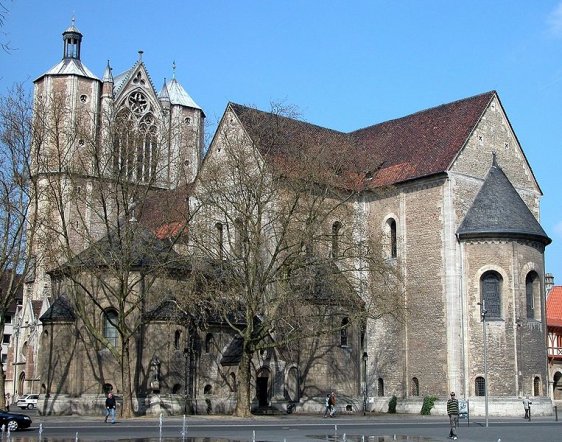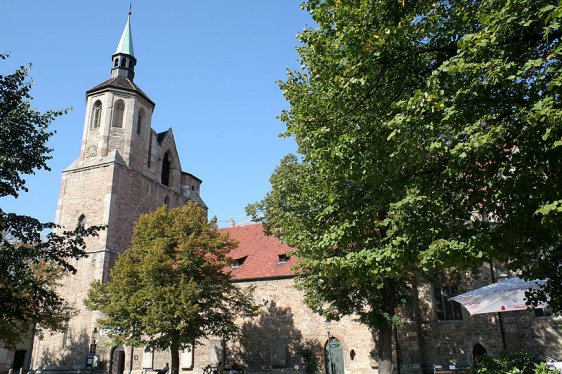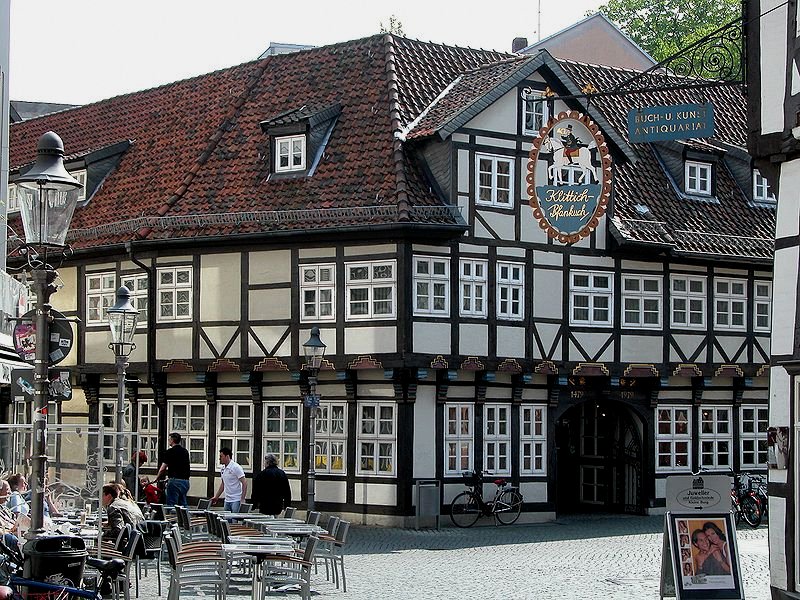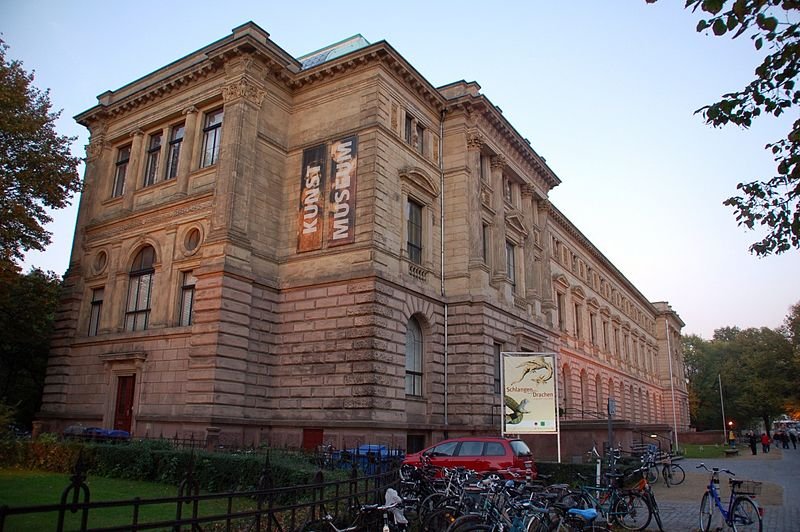 Braunschweig, Germany
Braunschweig, GermanySource: https://commons.wikimedia.org/wiki/File:Braunschweig_Brunswick_Luftbild_aus_Westen_%282007%29.JPG
Author: Brunswyk

Braunschweig (English: Brunswick; Low German: Brunswiek) is a city on the river Oker in Lower Saxony, Germany. Braunschweig covers 192.13 sq km (74.18 sq mi) and has a population of about 250,000 (2011 estimate). It observes the Central European Time (UTC+1) and in summer the Central European Summer Time (UTC+2).
 Interior of the reconstructed Burg Dankwarderode, the castle of Henry the Lion in Braunschweig
Interior of the reconstructed Burg Dankwarderode, the castle of Henry the Lion in BraunschweigSource: https://commons.wikimedia.org/wiki/File:BurgDankwarderodeRittersaal.jpg
Author: Roll-Stone

More on Braunschweig
Braunschweig is also called Brunswick in English, though in modern times that name is no longer as popular as the German name. (So I would suggest you stick with Braunschweig when you visit it.) Due to the personal union between the Duchy of Hanover with Great Britain from 1714 to 1837, various places in Britain and the Commonwealth is called Brunswick today, the most popular being the province of New Brunswick in Canada.The city of Braunschweig is at an average elevation of 74 m (246 ft). It is at the farthest navigable point of the Oker river, which flows down the Aller and Weser rivers into the North Sea. Braunschweig is today an important industrial city. It is home to two world renowned piano manufacturers, Schimmel and Grotrian-Steinway.
 Braunschweiger Dom (Brunswick Cathedral), Braunschweig
Braunschweiger Dom (Brunswick Cathedral), BraunschweigSource: https://commons.wikimedia.org/wiki/File:Braunschweig_Brunswick_Dom_Suedosten_%282008%29.JPG
Author: Brunswyk

Braunschweig has a well-known university as well as a number of research institutes. With 7.1% of its GDP going into research and technology (according to Eurostat, 2006), the Braunschweig area is the leading R&D area in the entire European Economic Area, earning it the title of Germany's City of Science in 2007.
It is not known exactly when Braunschweig was found, and by whom, and legends around it abounds. According to one, a settlement was established in AD 861. In any case, the city's name was first recorded in AD 1031, in the documents of the St. Magni Church, where it was stated as Brunesguik.
 Magnikirche (St Magnus' Church), Braunschweig
Magnikirche (St Magnus' Church), BraunschweigSource: https://commons.wikimedia.org/wiki/File:Braunschweig_Magnikirche_Gesamt.JPG
Author: Igge

Duke Henry the Lion (Heinrich der Löwe, 1129-1195) made Braunschweig his capital. He built the Cathedral of St. Blasius. Braunschweig was a member of the Hanseatic League from the 13th to the mid 17th century. It was a leading cultural center in 18th century Germany, and was the venue where Gotthold Ephraim Lessing's Emilia Galotti and Johann Wolfgang von Goethe's Faust were performed for the first time.
Being the residence of the rulers of the Duchy of Brunswick-Lüneburg, it was a constituent state of the Holy Roman Empire and later the German Empire. After the First World War, Braunschwieg was part of the Free State of Brunwick (Freistaat Braunschweig), which is within the Weimar Empire.
 Stiftsherrenhäuser, a half-timber house in Braunschweig
Stiftsherrenhäuser, a half-timber house in BraunschweigSource: https://commons.wikimedia.org/wiki/File:Braunschweig_Brunswick_Stiftsherrenhaeuser_%282008%29.JPG
Author: Brunswyk

Until the Second World War, Braunschweig had the largest ensemble of half-timbered houses in Germany. These were destroyed in the air raid of 15 October, 1944, which devastated the Old Town and most of the churches in the city. The Cathedral however escaped destruction.
After the war, Braunschweig ceased being a capital, as the Free State of Brunswick was incorporated into Lower Saxony. The Cathedral was restored to function as a Protestant church. The reconstruction of Braunschweig modernized the city, but radically altered the appearance of the Old Town. It followed a concept called Traditionsinsel, or tradition island, which leaves only a small section of the city still retaining its pre-war character.
 Herzog Anton Ulrich Museum, Braunschweig
Herzog Anton Ulrich Museum, BraunschweigSource: https://commons.wikimedia.org/wiki/File:Braunschweig_fg02.jpg
Author: Fritz Geller-Grimm

Visiting Braunschweig
Hannover Airport (HAJ) is the nearest airport to Braunschweig, about 40 minutes by car, and around an hour by train. You can also reach Braunschweig by train. Its railway station receives high-speed ICE train services from various major cities in Germany.Places of Interest in Braunschweig
- Altstadtmarkt (Old Town Market)
Market square to the west of the cathedral. - Braunschweiger Dom (Brunswick Cathedral)
The Romanesque-style cathedral dating back to the 13th century. - Braunschweiger Schloss (Brunswick Palace)
The former castle was rebuilt after World War II descruction, but brought into the modern age by incorporating a shopping mall inside. - Burglöwe (Brunswick Lion)
Replica of the lion statue installed by Henry the Lion at Castle Square. The original is now in a museum. - Gewandhaus (Cloth Hall)
Historic building, rebuilt in the Renaissance style. - Herzog-Anton-Ulrich-Museum
Art museum celebrated as the oldest museum in Germany, and second oldest in the world after the British Museum. - Jüdisches Museum (Jewish Museum)
The oldest Jewish museum in the world. - Magniviertel (St Magnus' Quarter)
The remaining part of Old Braunschweig, with cobblestoned streets, around the 13th century Magnikirche (St Magnus' Church) - Rathaus (Town Hall)
Two-storey L-shaped building at the Aldstadtmarkt.
 Latest updates on Penang Travel Tips
Latest updates on Penang Travel Tips

Copyright © 2003-2025 Timothy Tye. All Rights Reserved.

 Go Back
Go Back